Dermatological Skin Conditions
Our skin is the largest organ of the body and is exposed to a variety of external and internal factors that can lead to different skin conditions. Below are some common dermatological skin diseases, conditions and disorders; their descriptions, and brief explanations of their causes.
Table of Contents
Basal Cell Carcinoma / BCC
What is Basal Cell Carcinoma?
Basal cell carcinoma (BCC) is a prevalent type of skin cancer that arises from keratinocytes, often referred to as nonmelanoma skin cancer. It is the most common form of skin cancer and is sometimes called a rodent ulcer or basalioma. Individuals diagnosed with BCC frequently develop multiple primary tumors over the course of their lives.
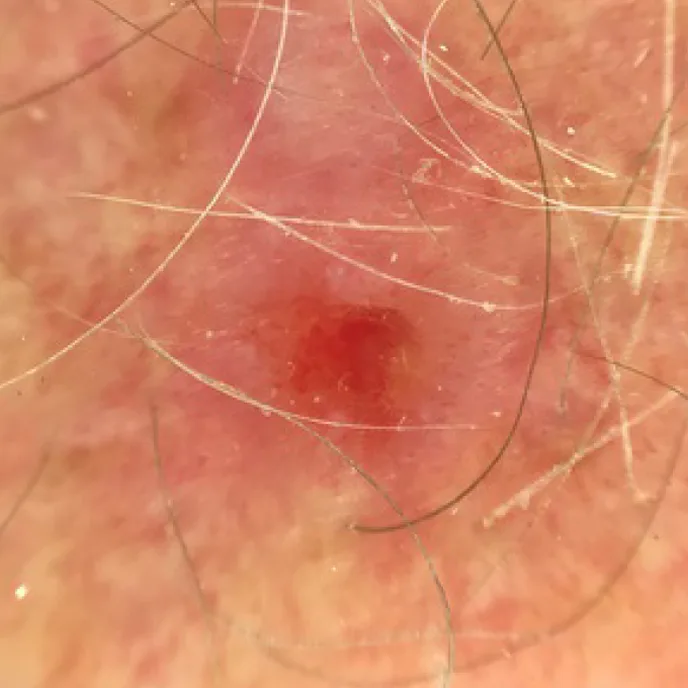
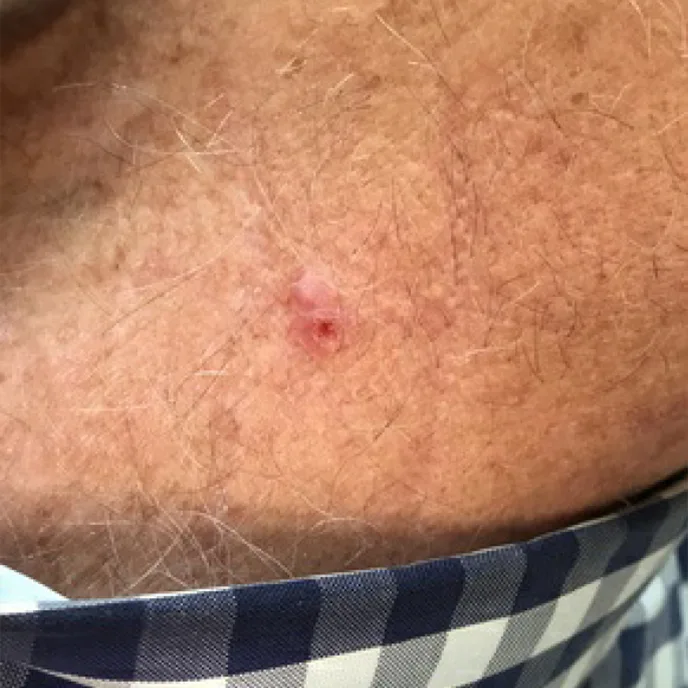
What causes Basal Cell Carcinoma?
The development of BCC is influenced by multiple factors:
- DNA mutations in the patched (PTCH) tumor suppressor gene, which is part of the hedgehog signaling pathway, are commonly involved.
- These mutations are often triggered by prolonged exposure to ultraviolet (UV) radiation.
- Both spontaneous genetic mutations and inherited gene defects can increase the risk of developing BCC.
Blue Naevus
What is a Blue Naevus?
Moles, or nevi, can show up on your skin in different shapes, sizes, and colors. One specific type is the blue nevus, named for its characteristic blue hue.
While these moles may look unusual, they’re typically benign and not something to worry about. However, as with any mole, it’s important to monitor them for any changes over time.
What causes a Blue Naevus?
The exact cause of blue nevi is unknown. They typically appear in children and young adults and are more common in women. Although malignant blue nevi are rare, men in their 40s may be at a slightly higher risk.
Blue nevi can develop at any age — some people are born with them, while others may develop them later in life.
It’s also common to have other types of moles along with a blue nevus. Most people have between 10 and 40 moles, with fair-skinned individuals often having more. Moles can also change in color, tone, or size as you grow older.
Bowen's Disease
What is Bowen's Disease?
Bowen’s disease is an early stage of squamous cell carcinoma, often referred to as squamous cell carcinoma in situ. It is a slow-growing cancer that affects the outermost layer of the skin, known as the epidermis. Although it is not immediately invasive, it is considered pre-invasive, meaning cancer cells are present but have not penetrated deeper skin layers.
If left untreated, Bowen’s disease has a small risk of progressing into an invasive form of squamous cell carcinoma, which can affect deeper layers of the skin. To prevent this, doctors either treat or closely monitor the condition.
Bowen’s disease can appear anywhere on the body but is most common on the:
- Head and neck
- Trunk
- Arms
- Legs
What causes Bowen's Disease?
In many cases, the exact cause of Bowen’s disease is unknown. However, prolonged exposure to sunlight or sunbeds is a common factor. Despite this, Bowen’s disease can occur in areas not typically exposed to the sun, indicating other causes as well.
A weakened immune system is another potential factor. This can result from conditions like acquired immune deficiency syndrome (AIDS) or from immunosuppressive medications taken after organ transplants, such as liver or kidney transplants.
Long-term arsenic exposure, often through contaminated drinking water, is another potential cause.
Compound Naevus
What is Compound Naevus?
A compound nevus is a type of mole in which melanocytes (pigment-producing cells) are found in both the epidermis (the outer layer of skin) and the dermis (the deeper layer beneath the epidermis). This distinguishes it from other types of moles, such as junctional nevi (where melanocytes are confined to the epidermis) and intradermal nevi (where melanocytes are found only in the dermis).
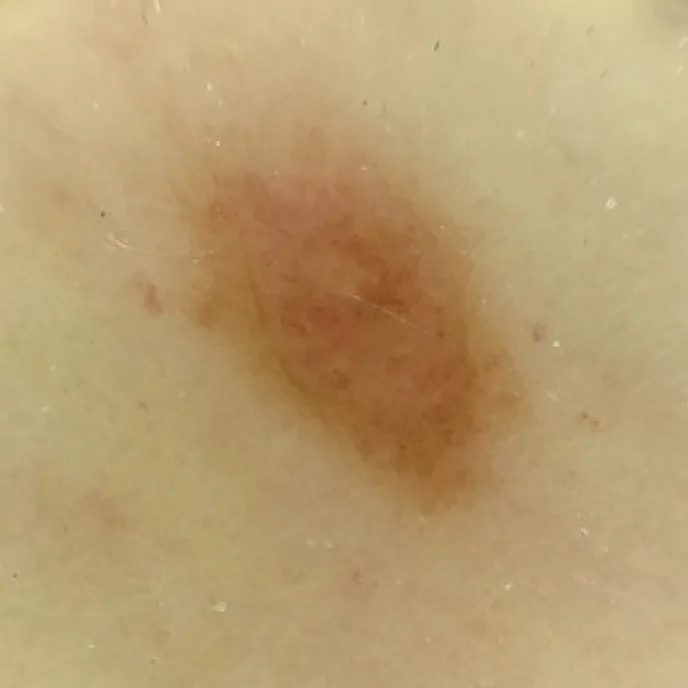


Key features of a compound nevus:
- Appearance: Usually raised and may have a slightly bumpy surface. It can be brown, black, or skin-colored, often darker in the center.
- Location: Melanocytes are found in both the epidermal-dermal junction and within the dermis.
- Common Age: Often appears in childhood or adolescence.
- Benign: Compound nevi are generally harmless but should be observed for any changes in size, shape, or color, as these can sometimes indicate a risk of malignant transformation.
Compound nevi may evolve over time, with some eventually becoming intradermal nevi as melanocytes migrate deeper into the skin.
What causes Compound Naevus?
The exact causes of a compound nevus are not fully understood, but several factors are believed to contribute to its development:
- Genetic Factors: A genetic predisposition can increase the likelihood of developing compound nevi. People with a family history of moles or nevi are more prone to developing them.
- Sun Exposure: Ultraviolet (UV) radiation from the sun can trigger the development of compound nevi. Excessive sun exposure, particularly during childhood, can cause melanocytes to proliferate, forming these types of moles.
- Hormonal Changes: Hormonal fluctuations, such as those occurring during puberty, pregnancy, or hormonal therapies, can stimulate the development of new moles, including compound nevi, or cause changes in existing ones.
- Aging: Compound nevi typically develop in childhood or adolescence but can also appear later in life as part of the natural aging process.
While compound nevi are usually benign, changes in size, shape, or color may warrant further medical evaluation, as they could indicate an increased risk of melanoma.
Dermatofibroma
What is Dermatofibroma?
A dermatofibroma is a common benign fibrous nodule typically found on the skin of the lower legs. It is also known as a cutaneous fibrous histiocytoma. These nodules are usually firm, raised, and can vary in color from brown to reddish. They are composed of fibrous tissue and are generally harmless, although they can be removed for cosmetic reasons or if they cause discomfort.
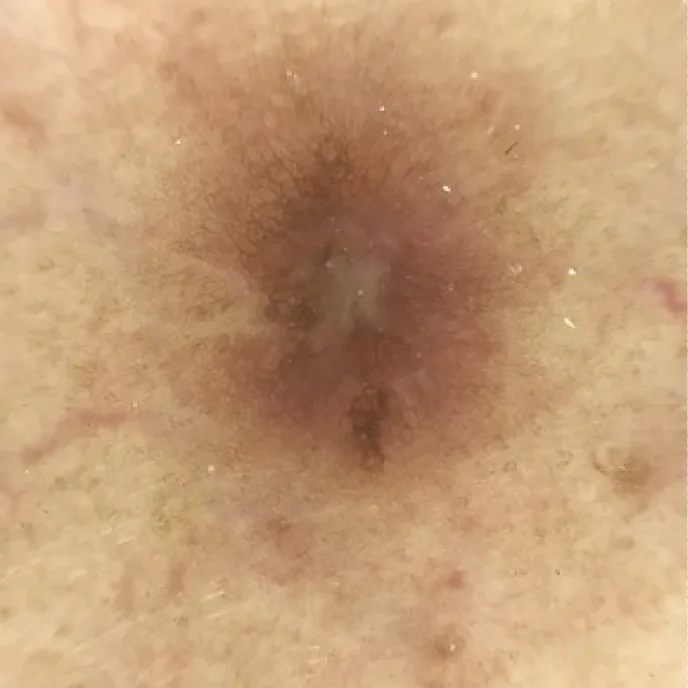
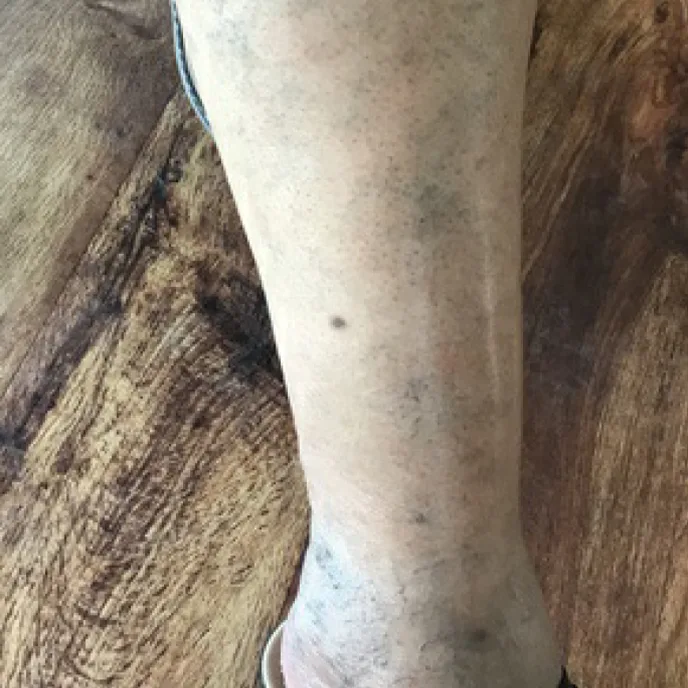
What causes Dermatofibroma?
The exact nature of dermatofibromas remains uncertain, with debate over whether they represent a reactive process or a true neoplasm. These lesions consist of proliferating fibroblasts, and histiocytes may also be involved. While dermatofibromas are sometimes linked to minor trauma, such as insect bites, injections, or injuries from rose thorns, this association is not consistent.
Additionally, multiple dermatofibromas can occur in individuals with altered immune systems, including those with HIV, immunosuppression, or autoimmune conditions.
Dysplastic Naevus / Atypical Mole
What is Dysplastic Naevus?
The term “dysplastic nevus” specifically refers to a mole with distinct microscopic characteristics. However, only a small percentage of clinically atypical nevi meet the criteria for a dysplastic nevus upon microscopic examination. Many nevi that are histologically dysplastic may appear clinically normal, often being small, uniformly colored, and structurally consistent.


What causes Dysplastic Naevus?
The causes of dysplastic nevi are primarily related to genetic and environmental factors:
- Genetic Factors: Individuals with a family history of dysplastic nevi or melanoma may have a higher risk due to inherited genetic mutations or susceptibility.
- Sun Exposure: Excessive UV radiation from the sun or tanning beds can contribute to the development of dysplastic nevi by causing genetic mutations in skin cells.
- Genetic Mutations: Specific genetic mutations and variations can lead to the development of dysplastic nevi. These mutations may affect the way skin cells grow and interact.
- Familial Syndromes: Certain inherited conditions, such as familial atypical multiple mole melanoma (FAMMM) syndrome, can increase the likelihood of developing dysplastic nevi.
Fibrosing Alopecia
What is frontal Fibrosing Alopecia?
Frontal fibrosing alopecia (FFA) is a condition that causes hair loss (alopecia) on the front and sides of the scalp. It can also affect hair on other areas of the body, most often the eyebrows.
FFA typically progresses over time. While treatments can help slow its progression, they cannot regrow hair that has already been lost.
What causes frontal Fibrosing Alopecia?
The exact cause of frontal fibrosing alopecia is unknown. However, researchers believe it may be linked to:
- Autoimmune disease, where the immune system attacks hair follicles. FFA may be a form of autoimmune disease called lichen planus, which causes scarring and inflammation of the scalp (lichen planopilaris).
- Genetics, as FFA sometimes runs in families.
- Hormones, since most people with FFA are post-menopausal.
- Surgeries such as facelifts or hair transplants.
Environmental factors might also trigger FFA in people with a genetic predisposition. These factors could include:
- Sun exposure.
- Viral infections.
- Certain medications.
- Pollutants (like dioxins) found in animal-based food.
- Use of sunscreens.
Folliculitis
What is Folliculitis?
Folliculitis occurs when hair follicles become inflamed or infected. Hair follicles are the tiny cavities that enclose the roots of your hair.
It can develop anywhere on the skin where hair grows, including the scalp. The condition most often affects areas like the thighs, buttocks, neck, and armpits — regions prone to friction. It typically appears as small bumps.
Folliculitis may resemble acne or a rash and can affect a single follicle or multiple ones. It can be short-term (acute) or long-lasting (chronic).
This condition is fairly common, and individuals with obesity are at a higher risk of developing it.
What causes Folliculitis?
Folliculitis is most commonly caused by Staphylococcus bacteria (Staph) or certain types of fungi. While Staph bacteria can be spread through direct contact with an infected person, fungal folliculitis is not contagious through physical touch. Other potential causes include:
- Viruses.
- Parasites.
- Certain medications.
- A weakened immune system.
You can also get Staph-related folliculitis by using contaminated items like razors, towels, or clothing previously used by someone with the condition.
Bacteria or fungi can also be contracted from poorly sanitized pools or spas.
Intradermal Naevus
What is Intradermal Naevus?
An intradermal nevus is a type of mole or birthmark that occurs within the dermis, the layer of skin located below the epidermis. Unlike other types of nevi, which may be located in the epidermis or at the junction between the epidermis and dermis, intradermal nevi are characterized by their placement entirely within the dermal layer.
Intradermal nevi are commonly seen in adults and are often removed for cosmetic reasons or if there is any concern about changes in appearance.
What causes Intradermal Naevus?
The exact cause of intradermal nevi is not fully understood, but several factors are believed to contribute to their development:
- Genetic Factors: A genetic predisposition can play a significant role, as some individuals may inherit a tendency to develop nevi.
- Sun Exposure: Prolonged or intense exposure to ultraviolet (UV) radiation from the sun or tanning beds may contribute to the formation of nevi, although intradermal nevi are generally less directly associated with sun exposure compared to other types of nevi.
- Hormonal Changes: Hormonal changes, such as those occurring during puberty or pregnancy, can influence the development of nevi.
- Skin Trauma: Repeated trauma or irritation to the skin might contribute to the formation of intradermal nevi, though this is less common.
- Aging: Intradermal nevi often develop in adulthood and may become more prominent with age due to changes in skin structure and pigmentation.
Overall, while these factors can influence the development of intradermal nevi, they are typically benign and not associated with cancer.
Junctional Naevus
What is Junctional Naevus?
A junctional nevus is a type of mole where the melanocytes (pigment-producing cells) are located at the junction between the epidermis (outer layer of skin) and the dermis (the layer just below). These nevi are usually flat or slightly raised and tend to be darker in color, ranging from brown to black.
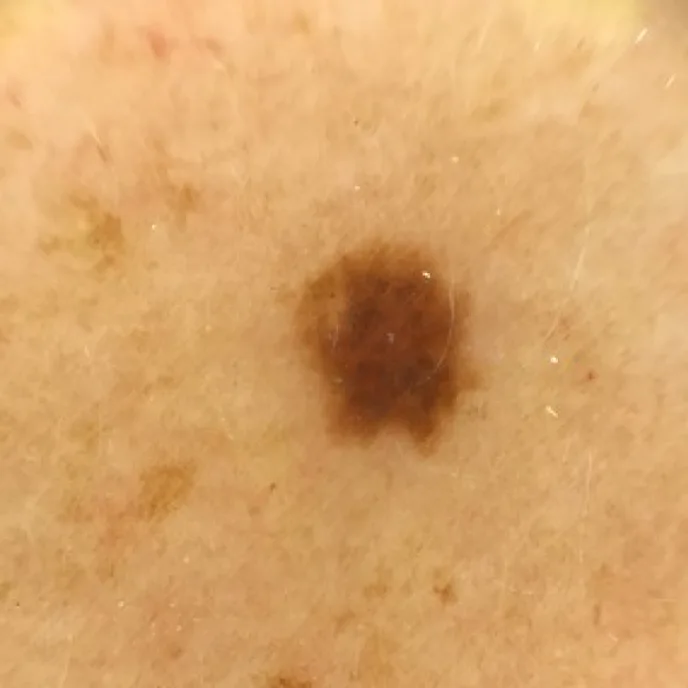
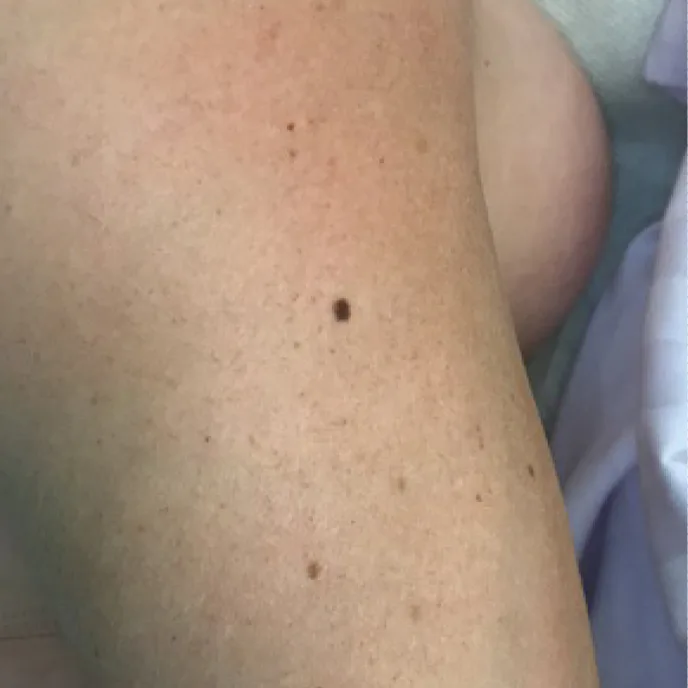
Key features of junctional nevi:
- Appearance: Typically flat, smooth, and uniformly pigmented.
- Location: Found at the junction of the epidermis and dermis.
- Age: Commonly appear in childhood or adolescence.
- Benign Nature: While generally harmless, junctional nevi can be monitored for changes, as alterations in size, shape, or color may warrant further evaluation for malignancy.
In some cases, junctional nevi can evolve into compound or intradermal nevi over time.
What causes Junctional Naevus?
The exact cause of a junctional nevus is not fully understood, but several factors may contribute to its development:
- Genetic Predisposition: Genetic factors play a significant role in the formation of moles, including junctional nevi. Individuals with a family history of moles are more likely to develop them.
- Sun Exposure: Ultraviolet (UV) radiation from the sun can stimulate melanocytes, potentially leading to the formation of new moles, including junctional nevi, or changes in existing ones.
- Hormonal Changes: Hormonal fluctuations during periods like puberty, pregnancy, or hormonal treatments can trigger the appearance of junctional nevi.
These moles are typically benign, but changes in size, shape, or color should be monitored, as they can occasionally indicate a risk of malignancy.
Keratoacanthoma
What is Keratoacanthoma?
A keratoacanthoma (KA) is a relatively common, fast-growing skin growth that typically develops on areas of the skin exposed to the sun, such as the face, arms, and hands. Although it closely resembles a type of skin cancer known as squamous cell carcinoma (SCC), a keratoacanthoma is benign (non-cancerous).
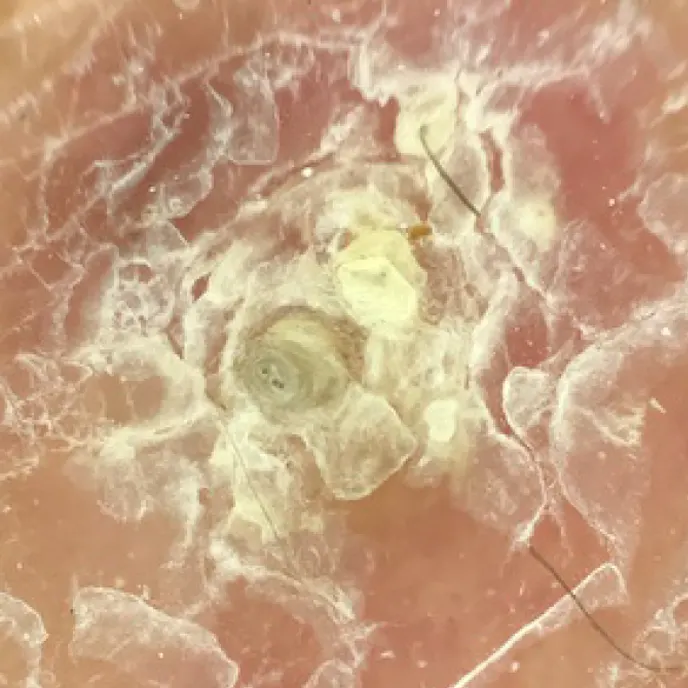
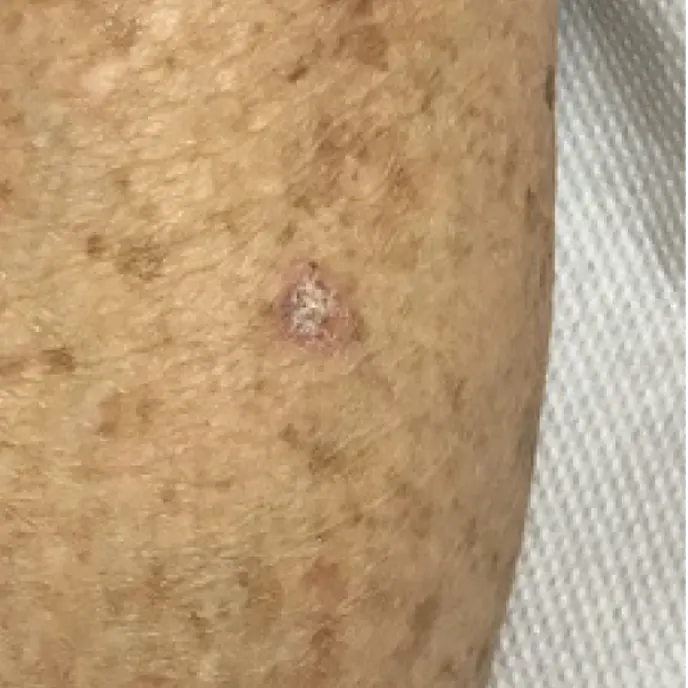
Key characteristics of keratoacanthomas include:
- Rapid growth: KAs can grow quickly, often reaching a size of 1–2 centimeters within a few weeks.
- Appearance: They usually present as dome-shaped nodules with a central keratin-filled crater.
- Location: Most often found on sun-exposed areas of the body.
While keratoacanthomas are generally harmless, they can sometimes be difficult to distinguish from squamous cell carcinoma without a biopsy. Therefore, healthcare providers often recommend removing and examining the growth to rule out malignancy.
What causes a Keratoacanthoma?
The exact cause of keratoacanthoma (KA) is not fully understood, but several factors are believed to increase the risk of developing this skin growth. These include:
- Sun Exposure: Prolonged exposure to ultraviolet (UV) rays is a significant risk factor, as KAs often develop on sun-exposed areas of the skin.
- Smoking: Tobacco use may contribute to the development of KAs.
- Older Age: KAs are more common in older individuals, typically those over the age of 60.
- Skin Injury: Trauma to the skin, such as cuts, burns, or surgical scars, may trigger the formation of a KA in some cases.
- Suppressed Immune System: Conditions or treatments that weaken the immune system, such as organ transplantation or certain medications, can increase the risk of KAs.
- Medications for Melanoma: Some drugs used to treat melanoma, such as BRAF inhibitors, have been associated with a higher risk of developing KAs.
If you have a history of melanoma or are undergoing treatment for it and are concerned about KAs, it’s important to discuss your risk factors and any skin changes with your doctor. Regular skin checks can help detect and address potential issues early.
Lentigo Simplex
What is Lentigo Simplex?
Lentigo simplex is the most common form of lentigo, characterized by a single or multiple lesions (lentigines) that may appear at birth or, more commonly, in early childhood. Unlike other types of lentigines, lentigo simplex is not triggered by sun exposure and is not linked to any underlying medical conditions. It is also known as simple lentigo or juvenile lentigo. These spots are generally harmless and benign.
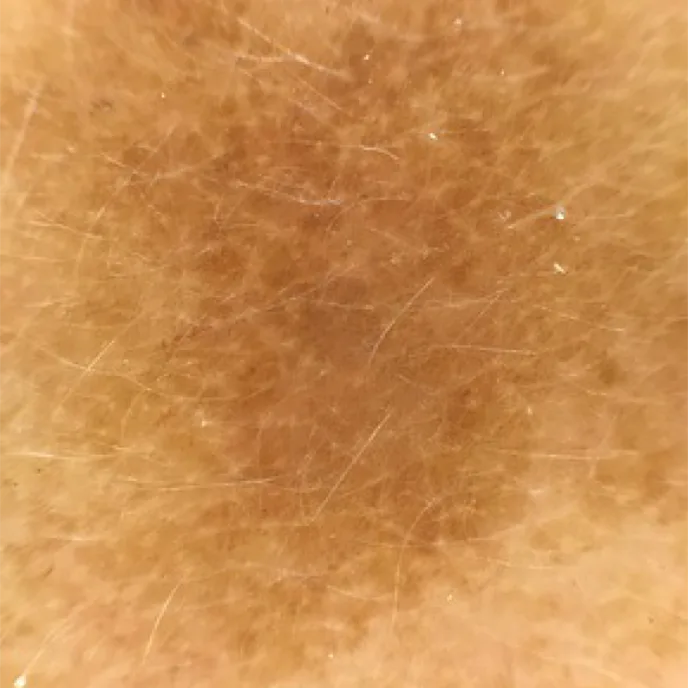
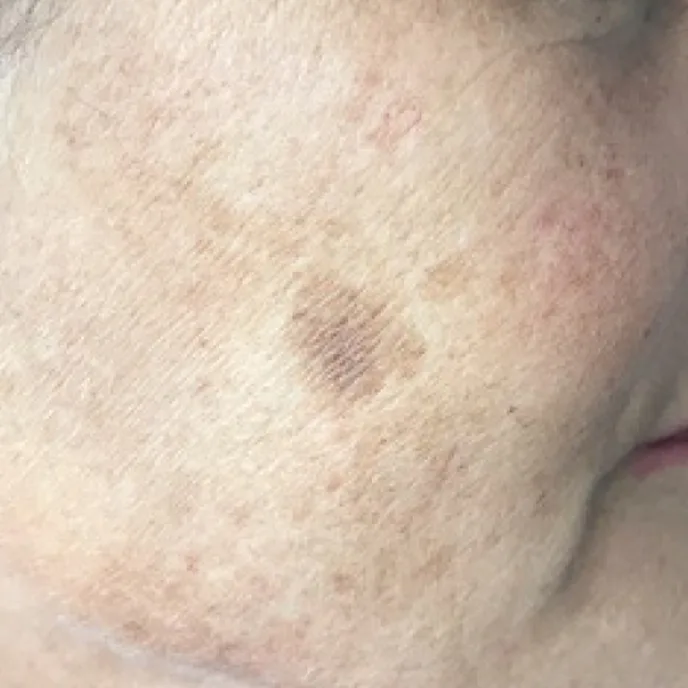
What causes Lentigo Simplex?
The exact cause of lentigo simplex is unknown. When multiple lentigines appear without any associated medical conditions, the condition is termed lentigines profusa or generalized lentigines. However, when multiple lentigines are accompanied by other abnormalities, they become part of specific disease syndromes, such as:
- Peutz-Jeghers syndrome
- Xeroderma pigmentosum
- LAMB syndrome
- LEOPARD syndrome
- Carney's complex
Each of these syndromes involves distinct clinical features beyond the presence of lentigines.
Melanoma
What is Melanoma?
Melanoma, also known as malignant melanoma, is a potentially life-threatening form of skin cancer characterized by the uncontrolled growth of melanocytes, the pigment-producing cells in the skin. Normally, melanocytes are located in the basal layer of the epidermis, where they produce melanin, a pigment that protects skin cells by absorbing harmful ultraviolet (UV) radiation. While non-cancerous growths of melanocytes lead to moles (benign melanocytic nevi) and freckles (ephelides and lentigines), the malignant growth of these cells results in melanoma.
What causes Melanoma?
Melanoma is believed to originate from the uncontrolled growth of melanin-producing cells (melanocytic stem cells) that have undergone genetic changes. These mutations can be either acquired or inherited. Acquired or ‘sporadic’ mutations, which occur due to cell damage over a person’s lifetime, are the most common cause of melanoma. The primary culprit is overexposure to UV radiation from the sun or tanning beds.
Inherited (familial) melanoma, though far less common (under 10%), results from germline mutations passed down from parents. The CDKN2A gene (also known as p16INK4A or MTS1) is linked to 20-40% of familial melanomas. Other genes such as CDK4, MC1R, MITF, TERT, ACD, BAP1, POT1, and TERF2IP have also been implicated in recent years.
Cutaneous melanoma can develop on seemingly normal skin (in approximately 75% of cases) or from an existing mole or freckle that begins to grow larger and change in appearance.
Melanoma In Situ
What is Melanoma In Situ?
Melanoma in situ is the earliest stage of melanoma, where cancerous cells are confined to the epidermis, the outermost layer of the skin. Also referred to as in-situ melanoma or level 1 melanoma, it has not yet spread to deeper layers. Since melanoma in situ poses no immediate threat to life, early detection is crucial for improving survival rates. Identifying melanoma at this early stage reduces the risk of complications, lowers treatment costs, and leads to better outcomes compared to more advanced stages of the disease.
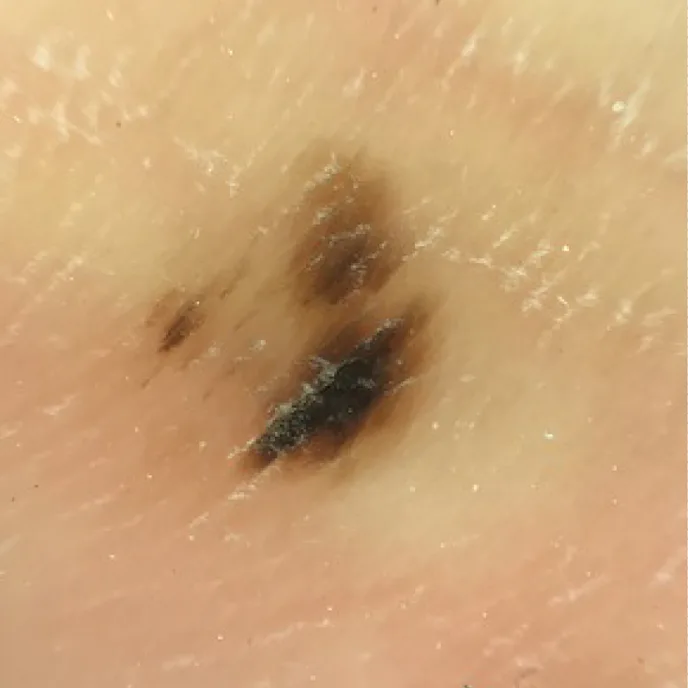
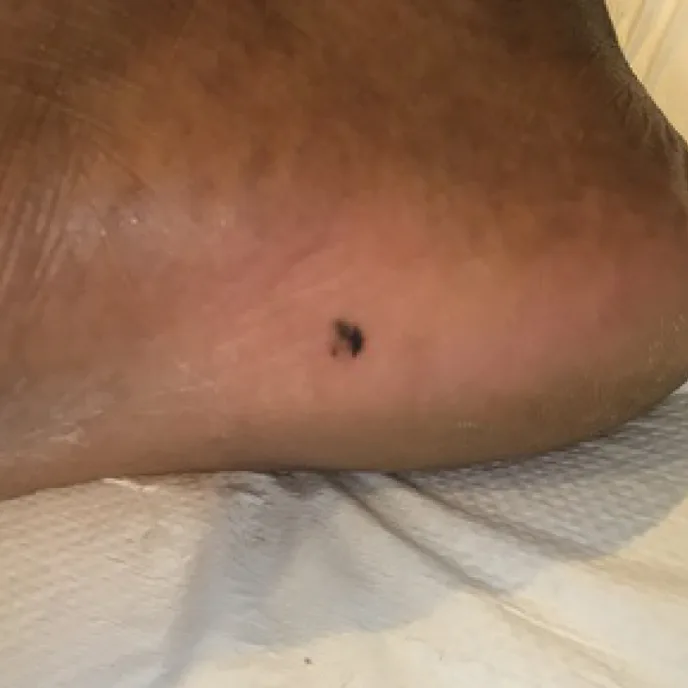

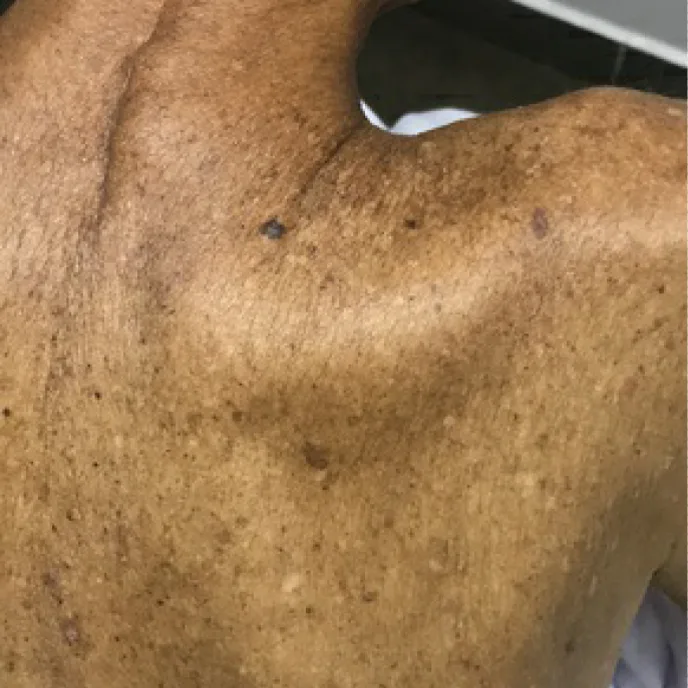
What causes Melanoma In Situ?
Melanoma in situ is marked by genetic mutations in the DNA of melanocytes, primarily caused by exposure to ultraviolet (UV) radiation. These mutations trigger abnormal cell growth, leading to the early development of melanoma, although the cancerous cells remain confined to the epidermis at this stage.
Pilomatricoma
What is Pilomatricoma?
Pilomatricoma is an uncommon, benign tumor that originates from hair matrix cells, which are involved in hair follicle development. Also spelled “pilomatrixoma,” it is sometimes referred to as “calcifying epithelioma of Malherbe.” Though harmless, pilomatricomas can present as firm, raised lumps under the skin and are typically found on the face, neck, or upper body.
What causes Pilomatricoma?
The cause of pilomatricoma is attributed to a localized mutation in hair matrix cells. This mutation involves an overactive proto-oncogene called BCL-2, which indicates that the normal process of cell death is suppressed. In most cases, mutations in the CTNNB1 gene lead to the dysregulation of a protein complex known as beta-catenin/LEF-1, contributing to the formation of the tumor. These genetic changes disrupt normal cell processes, leading to the benign growth seen in pilomatricomas.
Pleomorphic Salivary Adenoma of the Lip
What is a Pleomorphic Adenoma?
A pleomorphic adenoma is a benign (noncancerous) tumor that develops in the salivary glands, most commonly in the parotid glands. Treatment usually involves surgical removal of all or part of the affected gland. After removal, these tumors generally do not return.
What causes Pleomorphic Adenomas?
The exact cause of pleomorphic adenomas is unknown, but researchers have identified a few possible risk factors:
- Radiation exposure: Some studies indicate that pleomorphic adenomas can develop 15 to 20 years after radiation therapy for head and neck cancers.
- Chemical exposure: Contact with certain industrial chemicals, such as those used in rubber manufacturing, asbestos mining, or plumbing, may increase the risk.
Seborrhoeic Keratosis
What is Seborrhoeic Keratosis?
Seborrheic keratosis is a benign, warty growth commonly seen in adults as a sign of skin aging. These lesions can vary in number, with some individuals developing hundreds over their lifetime. Also known as seborrheic keratosis (American spelling: seborrheic keratosis), it may be referred to as SK, basal cell papilloma, senile wart, brown wart, wisdom wart, or barnacle.
The broader term “benign keratosis” encompasses several related scaly skin lesions, including:
- Seborrheic Keratosis: The primary condition, characterized by its warty appearance.
- Solar Lentigo: Often difficult to distinguish from a flat seborrheic keratosis, it is a sun-induced spot.
- Lichen Planus-Like Keratosis: A variant that can develop from an existing seborrheic keratosis or solar lentigo.
What causes Seborrhoeic Keratosis?
The exact cause of seborrheic keratoses is not well understood. Despite the name, these lesions are not confined to the seborrheic areas (such as the scalp, mid-face, chest, and upper back) associated with seborrheic dermatitis. They are not formed from sebaceous glands like sebaceous hyperplasia, nor are they related to sebum production, which is oily.
Seborrheic keratoses are considered degenerative in nature, meaning they tend to increase in number as individuals age. In some cases, a genetic predisposition can lead to the development of a large number of these lesions.
Actinic / Solar Keratosis
What is Actinic Keratosis?
Actinic keratosis is a precancerous, scaly spot that appears on skin damaged by sun exposure, also known as solar keratosis. It is considered an early form of cutaneous squamous cell carcinoma (a type of keratinocyte cancer) and may potentially develop into skin cancer if left untreated.
What causes Solar Keratosis?
Actinic keratoses develop due to abnormal skin cell changes resulting from DNA damage caused by short-wavelength UVB radiation. They are more likely to occur in individuals with compromised immune function, which can be due to aging, recent sun exposure, underlying health conditions, or the use of certain medications.
Squamous Cell Carcinoma Dermoscopy / SCC
What is Squamous Cell Carcinoma?
Cutaneous squamous cell carcinoma (SCC) is a common form of nonmelanoma skin cancer that originates from keratinocytes. It typically appears on sun-exposed areas of the skin and can become invasive, with the potential to spread (metastasize). Often referred to simply as SCC, it poses a greater risk than other nonmelanoma skin cancers due to its ability to metastasize.
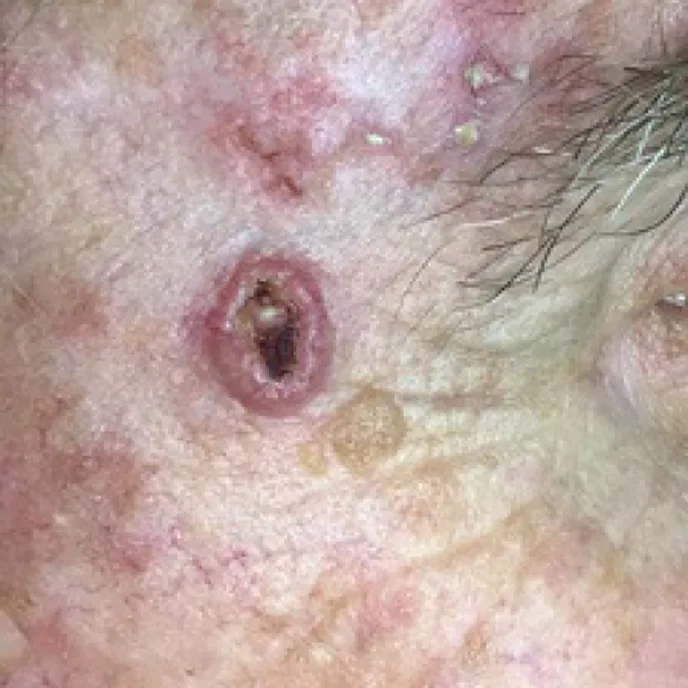

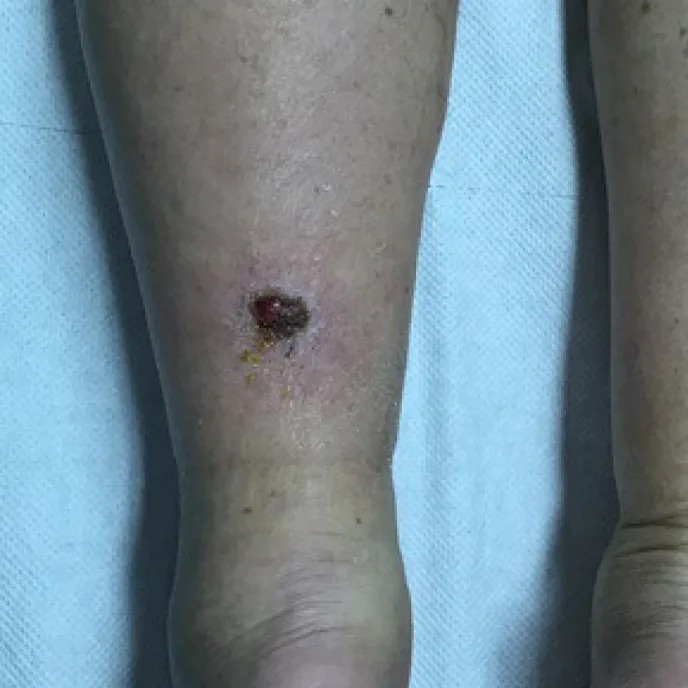
What causes Squamous Cell Carcinoma?
The causes of cutaneous squamous cell carcinoma (SCC) are linked to various factors, including:
- Prolonged exposure to ultraviolet (UV) radiation, primarily from the sun, which damages the DNA in skin cells.
- Tanning beds can also increase the risk of SCC due to artificial UV exposure.
- Chronic skin inflammation or injury, such as from burns or scars, can contribute to the development of SCC.
- Immunosuppression, whether from medications or medical conditions, weakens the body’s ability to repair skin cell damage.
- Exposure to carcinogens, such as arsenic or radiation, may also increase the likelihood of developing SCC.
- Genetic predisposition plays a role, with certain inherited conditions making some individuals more vulnerable to SCC.
Syringocystadenoma Papilliferum (SCAP)
What is Syringocystadenoma Papilliferum (SCAP)?
Syringocystadenoma papilliferum is a non-cancerous skin growth that comes from the sweat glands. It most often appears on the scalp or face and may look like a small bump or wart that can sometimes ooze or form a crust. This condition is usually present from birth or develops during childhood.

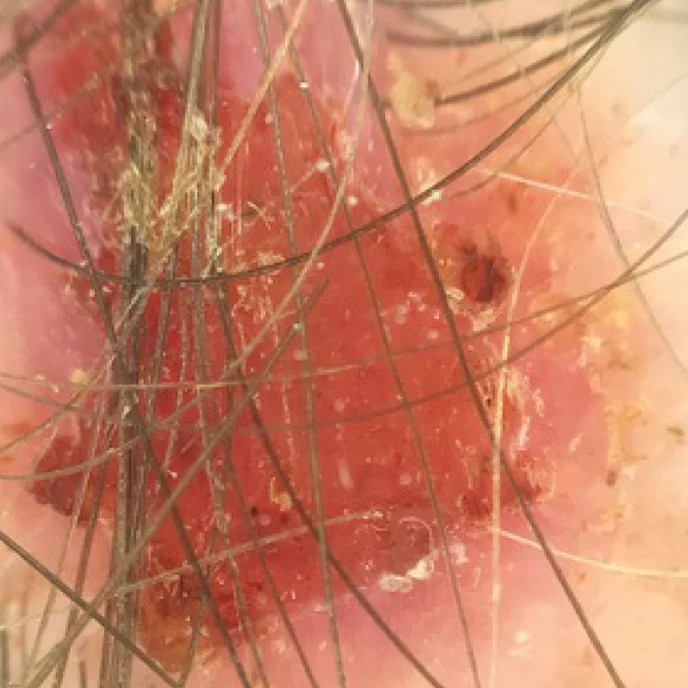
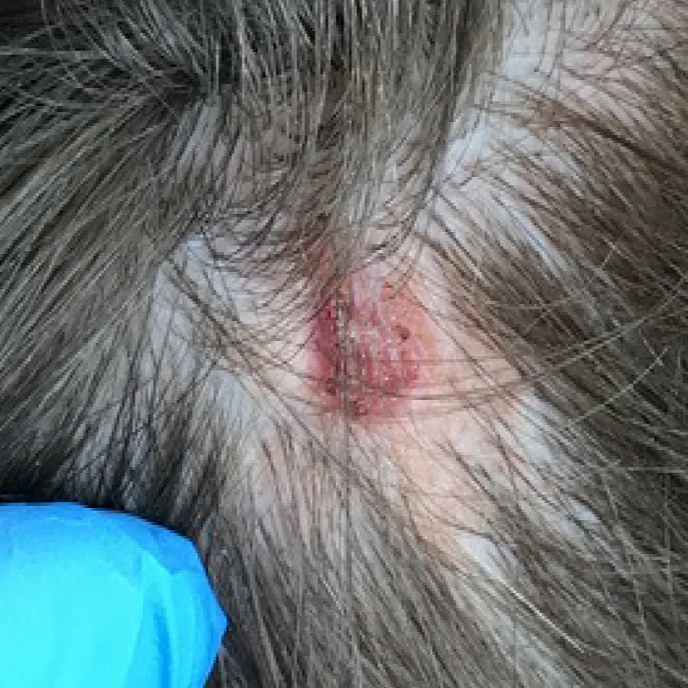
What causes Syringocystadenoma Papilliferum?
The exact cause is not fully understood, but it is believed to result from a developmental abnormality of the sweat glands. Genetic mutations – particularly in the HRAS or BRAF genes are often involved. It may occur on its own or within a nevus sebaceus (a type of congenital skin lesion).
Warty Papilloma (Verruca Vulgaris)
What is Warty Papilloma (Verruca Vulgaris)?
Warty squamous cell papillomata, also known as verrucae or warts, are benign skin growths caused by an infection with the human papillomavirus (HPV). These growths typically have a rough texture and can vary in size and appearance. They are non-cancerous and can develop on various parts of the body, including the hands, feet, face, and genital areas.
Warts are classified into different types based on their location and appearance, such as common warts, plantar warts (on the soles of the feet), flat warts, and genital warts. While generally harmless, they can be unsightly, painful (e.g., plantar warts), or contagious.
What causes Warty Papilloma (Verruca Vulgaris)?
Warts are caused by an infection with certain types of HPV. This virus infects the top layer of the skin (epidermis), usually through small cuts or abrasions. HPV leads to rapid skin cell growth, forming the raised lesion.
Key factors that contribute to their development include:
- Direct Contact: Touching warts on another person or on yourself.
- Indirect Contact: Contact with surfaces or objects contaminated with HPV, such as towels, razors, or communal showers.
- Weakened Immune System: Individuals with reduced immunity are more prone to HPV infections.
Different Strains of HPV are implicated in cutaneous or mucosal verruca. with low-risk types typically causing common warts.
Experience yourself
Dermatologist
Dr. Venkatesh is a distinguished Kenyan Dermatologist in Nairobi, with a passion for clinical…

